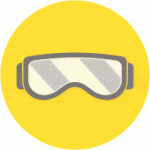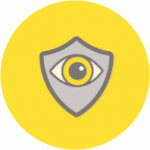For most of us, digital devices have a strong and growing presence in our lives. Computers, tablets, smartphones and other electronic devices with visual displays can all cause tired eyes and digital eye strain, or what’s known as ‘computer vision syndrome’.
What is computer vision syndrome and what causes it?
Computer vision syndrome is the name for a group of eye and vision symptoms that might be experienced as a result of extended periods of viewing digital devices.
These symptoms include eye strain, red or tired eyes, irritation, blurred vision, double vision and headaches.
For most of us, our eyes prefer to focus further than six metres away, so viewing a computer screen forces our eyes to work harder. Often the type we are viewing on a digital device can be small or unclear, and glare is emitted off the screen from the blue light. Also, while it’s normal for us to blink about 15 times a minute, studies have shown that we blink far less often while using digital devices.
The combination of these unique characteristics and our eyes having to work harder can often lead to difficulty. The extent to which people experience visual symptoms often depends on the level of their visual abilities and the amount of time looking at a digital screen.
The muscles which control eye movements and focusing are typically relaxed when we look at objects in the distance. Extended periods of focusing on screens up close results in the muscles having to exert significant focusing effort to make these objects clear. As with any of the muscles in the body they can fatigue and tire out if not given the opportunity to rest and relax occasionally. Often the type we are viewing on a digital device can be small or unclear, and glare from screens may also exacerbate problems. The frequency of blue light emitted from LED devices is also being researched for its long term effects on the eye and potential impact on altering sleep cycles. Also, while it’s normal for us to blink about 15 times a minute, studies have shown that we blink far less often while using digital devices resulting in dry, scratchy and red eyes.

Tips for minimising eye strain when using digital devices
Follow these tips to help minimise computer vision syndrome:
- Sit at least an arm’s length from the computer screen, and try not to hold your tablet or smartphone too close to your eyes.
- Take regular breaks using the 20/20/20 rule: every 20 minutes, shift your eyes to look at an object at least 20 feet away (six metres), for at least 20 seconds.
- Use lubricant eye-drops or artificial tears to refresh your eyes when they feel dry. Consider using a humidifier if working in an air-conditioned or heated environment.
- Avoid using screens in an otherwise dark room and set up computer screens so there are not reflections from windows on the screen.
- Apps and programs like F.Lux and Apple Night Shift can help reduce blue light from LED screens, particularly helpful for those using devices late at night.
- Common conditions such as myopia, hyperopia, astigmatism or presbyopia can exacerbate eye strain so ensure you have regular eye examinations with your optometrist to maintain good vision, for life.











